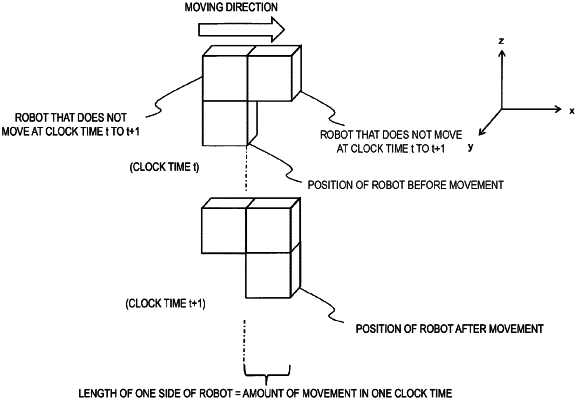| CPC B25J 9/1617 (2013.01) [B25J 9/1602 (2013.01)] | 9 Claims |

|
1. A mobile robot set comprising:
a plurality of robots,
wherein the plurality of robots forms a gap around one or more robots of the plurality of robots, the mobile robot set moves using the gap,
a first robot of the plurality of robots is associated with a predetermined initial position and a predetermined target position,
the predetermined initial position and the predetermined target position are in contact at a connecting position,
the first robot is for moving from the predetermined initial position to the predetermined target position through the connecting position, and
the first robot is located at the connecting position, and a processor configured to execute operations comprising:
transmitting, by the first robot to a second robot of the plurality of robots, a position distance calculation instruction,
wherein at least a part of the second robot is in contact with to the first robot as being adjacent to each other, the position distance calculation instruction includes predetermined values of a relative position from the connecting position and a number of transmissions and transfers;
when the second robot receives the position distance calculation instruction:
incrementing, by the second robot, the number of transmissions and transfers in the received position distance calculation instruction;
updating, by the second robot, the relative position in the position distance calculation instruction in accordance with a direction from which the position distance calculation instruction is received;
transferring, the updated relative position and the position distance calculation instruction to a third robot of the plurality of robots;
storing, by the second robot, as a root direction, a direction of the first robot;
receiving, by the first robot, a reply position distance calculation instruction from the second robot, wherein the reply position distance calculation instruction includes the incremented number of transmissions and transfers and the updated relative position;
determining, by the first robot, a movement start clock time for each of the plurality of robots based on a position of each of the plurality of robots according to at least the relative position in the reply position distance calculation instruction; and
transmitting, by the first robot, an operation clock time announcement instruction to the second robot, wherein the operation clock time announcement instruction includes the movement start clock time;
transferring the operation clock time announcement instruction to the third robot;
when a predetermined time elapses after a start of the moving by the first robot, transmitting, by the first robot, a movement start instruction to the second robot;
transferring, by the second robot the movement start instruction to the third robot;
acquiring, by the first robot reaching the connecting position, a target position of the first robot and a path to reach the target position of the first robot from the connecting position;
moving, by the first robot, to the acquired target position according to the path to reach the target position of the first robot;
determining, by the first robot, whether there is the second robot at an adjacent position to which the first robot is about to move next;
when there is the second robot at the adjacent position to which the first robot is about to move and when the adjacent position to which the first robot is about to move is the target position of the first robot, moving, by the first robot, to the adjacent position;
subsequent to the moving by the first robot to the adjacent position, moving, by the second robot, in accordance with a target position of the second robot and a path of the second robot;
transmitting, by the second robot, a waiting instruction, wherein the waiting instruction includes a predetermined waiting time to the third robot; and
causing the third robot to stop movement for the predetermined waiting time and to transfer, by the third robot, the waiting instruction to an adjacent robot.
|